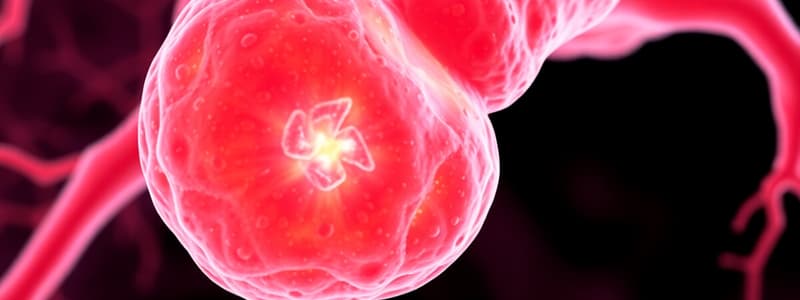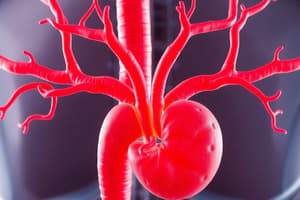Podcast
Questions and Answers
A researcher is studying hormone secretion patterns in a group of patients. Which of the following findings would most strongly suggest a disruption in the circadian rhythm of hormone release?
A researcher is studying hormone secretion patterns in a group of patients. Which of the following findings would most strongly suggest a disruption in the circadian rhythm of hormone release?
- Consistently low cortisol levels, with no significant peak in the morning. (correct)
- Steady release of insulin in response to continuous glucose infusion.
- Unpredictable bursts of luteinizing hormone (LH) secretion, varying in frequency and amplitude.
- Consistent, elevated levels of growth hormone throughout the day and night.
A patient presents with symptoms suggesting an adrenal cortex disorder. If tests reveal elevated levels of androgens but normal levels of cortisol and aldosterone, which layer of the adrenal cortex is most likely affected?
A patient presents with symptoms suggesting an adrenal cortex disorder. If tests reveal elevated levels of androgens but normal levels of cortisol and aldosterone, which layer of the adrenal cortex is most likely affected?
- The zona reticularis, responsible for androgen secretion. (correct)
- The adrenal medulla, responsible for catecholamine secretion.
- The zona fasciculata, responsible for cortisol secretion.
- The zona glomerulosa, responsible for aldosterone secretion.
Damage to the hypothalamus could directly disrupt the function of the adrenal cortex by affecting the secretion of which of the following hormones?
Damage to the hypothalamus could directly disrupt the function of the adrenal cortex by affecting the secretion of which of the following hormones?
- Aldosterone
- Cortisol
- ACTH (correct)
- Angiotensin II
A drug that selectively blocks the action of angiotensin II would most directly affect the secretion of which hormone?
A drug that selectively blocks the action of angiotensin II would most directly affect the secretion of which hormone?
In paracrine hormone secretion within the testes, which of the following best describes the mechanism by which testosterone influences sperm production?
In paracrine hormone secretion within the testes, which of the following best describes the mechanism by which testosterone influences sperm production?
A patient is diagnosed with a tumor that causes excessive secretion of growth hormone (GH). Considering the typical secretion pattern of GH, at what time of day would you expect the highest levels of GH in this patient?
A patient is diagnosed with a tumor that causes excessive secretion of growth hormone (GH). Considering the typical secretion pattern of GH, at what time of day would you expect the highest levels of GH in this patient?
Which description accurately describes the role of specific metabolites in stimulating hormone secretion?
Which description accurately describes the role of specific metabolites in stimulating hormone secretion?
If a researcher is studying a hormone that is released in response to neural signals, which of the following is an accurate example?
If a researcher is studying a hormone that is released in response to neural signals, which of the following is an accurate example?
A patient presents with symptoms of hypogonadism. Initial tests reveal low levels of LH and FSH, but normal levels of GnRH. Where is the most likely location of the dysfunction?
A patient presents with symptoms of hypogonadism. Initial tests reveal low levels of LH and FSH, but normal levels of GnRH. Where is the most likely location of the dysfunction?
A researcher is studying the effects of a novel drug on the HPT axis. The drug significantly reduces the secretion of TSH. Which of the following is the most likely mechanism of action of this drug?
A researcher is studying the effects of a novel drug on the HPT axis. The drug significantly reduces the secretion of TSH. Which of the following is the most likely mechanism of action of this drug?
A patient is diagnosed with a tumor that secretes excessive amounts of somatostatin. Which of the following hormonal imbalances would most likely be observed in this patient?
A patient is diagnosed with a tumor that secretes excessive amounts of somatostatin. Which of the following hormonal imbalances would most likely be observed in this patient?
In a patient with primary hyperthyroidism (overproduction of thyroid hormones by the thyroid gland), what would you expect to see?
In a patient with primary hyperthyroidism (overproduction of thyroid hormones by the thyroid gland), what would you expect to see?
Which of the following best describes the mechanism by which chronically elevated levels of cortisol (e.g., due to Cushing's syndrome) affect the hypothalamus and anterior pituitary?
Which of the following best describes the mechanism by which chronically elevated levels of cortisol (e.g., due to Cushing's syndrome) affect the hypothalamus and anterior pituitary?
A researcher discovers a new hormone that exhibits ultrashort-loop feedback regulation. Which of the following is the most likely mechanism of action for this hormone?
A researcher discovers a new hormone that exhibits ultrashort-loop feedback regulation. Which of the following is the most likely mechanism of action for this hormone?
A 30-year-old female presents with irregular menstrual cycles and difficulty conceiving. Hormone testing reveals elevated levels of prolactin. Which of the following hypothalamic dysfunctions is most likely contributing to this patient's condition?
A 30-year-old female presents with irregular menstrual cycles and difficulty conceiving. Hormone testing reveals elevated levels of prolactin. Which of the following hypothalamic dysfunctions is most likely contributing to this patient's condition?
A patient is suspected of having a pituitary adenoma that is interfering with the normal function of gonadotroph cells. Which hormone levels are most likely to be affected?
A patient is suspected of having a pituitary adenoma that is interfering with the normal function of gonadotroph cells. Which hormone levels are most likely to be affected?
A patient with long-standing uncontrolled type 2 diabetes mellitus is likely to exhibit which of the following endocrine abnormalities over time?
A patient with long-standing uncontrolled type 2 diabetes mellitus is likely to exhibit which of the following endocrine abnormalities over time?
Which of the following scenarios describes a situation where product regulation is primarily influencing hormone secretion?
Which of the following scenarios describes a situation where product regulation is primarily influencing hormone secretion?
Flashcards
Hormone Secretion Stimuli
Hormone Secretion Stimuli
Signals that trigger the release of hormones, such as neurotransmitters and metabolites.
Neurotransmitters
Neurotransmitters
Chemicals like dopamine and epinephrine that stimulate hormone secretion.
Circulating Hormones
Circulating Hormones
Hormones that act as signals in the bloodstream, like T3 and T4 responding to TSH.
Paracrine Hormone Secretion
Paracrine Hormone Secretion
Signup and view all the flashcards
Adrenal Gland Structure
Adrenal Gland Structure
Signup and view all the flashcards
Circadian Secretion
Circadian Secretion
Signup and view all the flashcards
Episodic Secretion
Episodic Secretion
Signup and view all the flashcards
Role of the Hypothalamus
Role of the Hypothalamus
Signup and view all the flashcards
Hypothalamus
Hypothalamus
Signup and view all the flashcards
HPG Axis
HPG Axis
Signup and view all the flashcards
HPA Axis
HPA Axis
Signup and view all the flashcards
HPT Axis
HPT Axis
Signup and view all the flashcards
GHRH
GHRH
Signup and view all the flashcards
Negative Feedback
Negative Feedback
Signup and view all the flashcards
Hyper-secretion
Hyper-secretion
Signup and view all the flashcards
Hypo-responsiveness
Hypo-responsiveness
Signup and view all the flashcards
Somatostatin
Somatostatin
Signup and view all the flashcards
Product Regulation
Product Regulation
Signup and view all the flashcards
Study Notes
Hormone Secretion
- Hormone secretion is stimulated by various signals, including neurotransmitters, neural hormones, circulating hormones, paracrine hormones, and metabolites.
- Neurotransmitters: Examples include glutamate, GABA, dopamine, epinephrine, norepinephrine, histamine, and serotonin.
- Neural Hormones: Hypothalamic hormones stimulate the pituitary.
- Circulating Hormones: Gonads respond to LH and FSH; the thyroid responds to TSH.
- Paracrine Hormones: Within a gland (e.g., testosterone stimulating sperm production).
- Metabolites: Glucose, amino acids, and calcium can stimulate hormone secretion.
Adrenal Gland
- Located atop the kidneys, the adrenal gland has two parts: medulla and cortex.
- The adrenal cortex has three layers:
- Glomerulosa (outermost): Stimulated by angiotensin II to secrete aldosterone.
- Fasciculata (middle): Stimulated by ACTH to secrete cortisol.
- Reticularis (innermost): Stimulated by ACTH to secrete androgens.
Hormone Secretion Patterns
-
Circadian Secretion: A daily cycle, with cortisol peaking in the morning.
-
Episodic Secretion: Burst-like release (e.g., hypothalamic and pituitary hormones, growth hormone at night).
-
Secretion patterns are influenced by sleep, activity, meals, and temperature.
The Hypothalamus
- The hypothalamus is a central integrator of information from various sources (thalamus, limbic system, etc.) and the environment.
- It processes this information and secretes hormones to regulate the pituitary and maintain homeostasis.
Hypothalamus and Endocrine Axis
- The hypothalamus regulates the pituitary gland, which affects target organs.
- HPG Axis (Hypothalamus-Pituitary-Gonads): GnRH → LH/FSH → Gonadal hormones (estrogen, androgen, progesterone).
- HPA Axis (Hypothalamus-Pituitary-Adrenal): CRH → ACTH → Cortisol/Aldosterone.
- HPT Axis (Hypothalamus-Pituitary-Thyroid): TRH → TSH → T3/T4.
- Other hypothalamic hormones:
- GHRH stimulates growth hormone secretion, affecting metabolism and IGF production.
- Somatostatin inhibits growth hormone and TSH secretion.
- Dopamine and TRH stimulate prolactin production.
Anterior Pituitary Hormones
- Anterior pituitary hormones and their characteristics
Hormone Cell Type Structure ACTH Corticotroph 39 amino acids TSH Thyrotroph α subunit shared with LH/FSH, unique β subunit LH Gonadotroph α subunit shared with TSH/FSH, unique β subunit FSH Gonadotroph α subunit shared with TSH/LH, unique β subunit
Regulation of Hormone Secretion
- Negative Feedback: Target organ hormones inhibit pituitary/hypothalamic hormones (long, short, ultra-short loops).
- Positive Feedback: Target organ hormones stimulate pituitary/hypothalamic hormones. (e.g., estrogen).
- Product Regulation: Hormone action products (e.g., sodium, calcium, glucose) influence secretion. (e.g., high calcium inhibits PTH)
Endocrine Disorders
- Hypo-secretion: Low hormone levels; caused by target gland destruction, pituitary dysfunction, or hypothalamic dysfunction.
- Hyper-secretion: High hormone levels; caused by target gland over-secretion, pituitary over-stimulation, or hypothalamic over-stimulation.
- Hypo-responsiveness: Decreased response to a hormone (e.g., type 2 diabetes, insulin resistance).
- Hyper-responsiveness: Increased response to a hormone (e.g., overgrowth).
Test of Knowledge Questions (Answers)
- Question 1: Cortisol secretion is circadian, peaking in the morning, part of the HPA axis.
- Question 2: Chronic hydrocortisone use suppresses the HPA axis, decreasing ACTH levels.
Studying That Suits You
Use AI to generate personalized quizzes and flashcards to suit your learning preferences.




